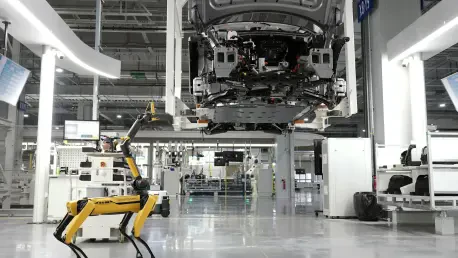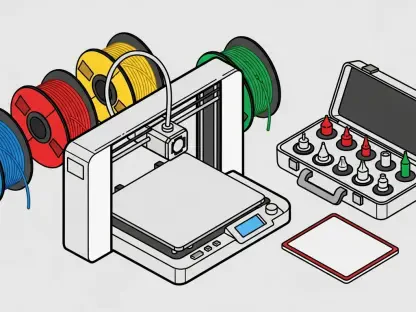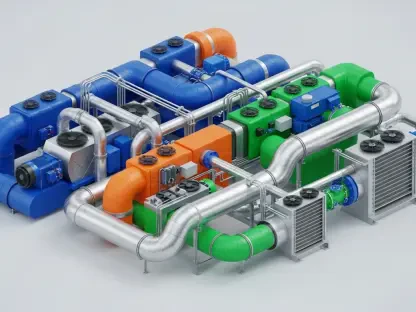Fixed version:
In the heart of Australia’s industrial landscape, the manufacturing sector grapples with some of the highest rates of workplace injuries and legal challenges, painting a stark picture of an industry in dire need of transformative safety solutions. Recent data reveals that manufacturing accounts for a significant portion of serious workers’ compensation claims and faces frequent Work Health and Safety prosecutions, highlighting the urgency for innovative approaches to protect workers. Enter generative AI, a groundbreaking technology that promises to reshape safety practices by turning vast troves of data into actionable insights. This article delves into the potential of generative AI to not only mitigate risks but also enhance operational efficiency in one of Australia’s most hazardous industries. From analyzing historical incident records to aligning with stringent regulatory demands, the technology offers a path forward for manufacturers aiming to safeguard their workforce while boosting productivity. Let’s explore how this cutting-edge tool can make a tangible difference.
Revolutionizing Safety with Advanced Analytics
Generative AI, particularly through the power of large language models (LLMs), stands to transform safety analytics in Australian manufacturing by processing immense volumes of unstructured data such as incident reports, safety audits, and handwritten logs. This technology excels at digitizing historical records using modern optical character recognition tools, making previously inaccessible information available for analysis. By identifying recurring patterns in accidents—whether tied to specific machinery or locations—AI enables safety officers to shift from a reactive stance to a preventive one. The ability to extract meaningful insights from chaotic datasets means that potential hazards can be flagged long before they result in harm. This approach empowers manufacturers to allocate resources effectively, targeting high-risk areas with precision and ensuring that every decision is grounded in evidence rather than guesswork, ultimately fostering a safer working environment across factory floors.
Beyond data processing, generative AI tackles the challenge of fragmented information by integrating disparate sources like maintenance logs, internal emails, and scattered databases into a cohesive framework. This synthesis eliminates data silos that often hinder comprehensive safety assessments, providing a unified view of risks across an organization. Paired with business intelligence tools, AI can generate visual dashboards that highlight critical trends and areas needing urgent attention, making complex information accessible to safety teams. However, the importance of human oversight cannot be overstated—professionals must validate AI-generated insights to ensure their accuracy and relevance to specific workplace contexts. Through structured consultations with employees, manufacturers can refine these findings, ensuring that technology serves as a supportive tool rather than an unchecked authority. This balanced approach maximizes the potential of AI to enhance safety while maintaining the critical human element in decision-making processes.
Addressing a High-Risk Industry’s Urgent Needs
Australian manufacturing remains a notably high-risk sector, burdened by a disproportionate share of workplace injuries and legal repercussions under Work Health and Safety regulations. The persistent threat of accidents, ranging from equipment malfunctions to human error, underscores the critical need for innovative safety measures that can keep pace with the industry’s demands. Generative AI emerges as a vital ally in this struggle, offering the ability to analyze past incidents and identify early warning signs of potential dangers. By learning from historical data, the technology can predict where risks are most likely to emerge, allowing companies to intervene proactively. This shift from merely responding to accidents to preventing them marks a significant leap forward, promising not only to protect employees but also to reduce the financial and reputational costs associated with workplace mishaps.
Furthermore, the adoption of generative AI in safety protocols can yield substantial economic benefits for manufacturers facing constant pressure from downtime and rising insurance costs. A proactive safety strategy driven by AI insights helps minimize disruptions caused by accidents, ensuring smoother operations and less absenteeism among workers. Additionally, a demonstrably lower risk profile can lead to reduced insurance premiums, providing direct financial relief to businesses often strained by tight margins. This technology also supports compliance with stringent safety laws, helping firms avoid penalties and legal battles that can tarnish their standing. By embedding AI into their safety frameworks, manufacturers can create a culture of prevention that resonates throughout the organization, reinforcing their commitment to employee well-being while strengthening their operational foundation in a competitive market.
Establishing Robust Data Governance for Success
For generative AI to deliver reliable safety outcomes in manufacturing, a strong foundation of data governance must be in place to manage the diverse and often disorganized information streams within the sector. Manufacturers handle an array of data types, from sensor outputs and audio recordings to decades-old paper records, much of which lacks proper structure or oversight. Without rigorous management, the principle of “garbage in, garbage out” prevails, rendering AI outputs unreliable and potentially misleading. Establishing clear protocols for data quality and accessibility ensures that historical safety lessons are not lost to outdated systems but are instead transformed into actionable intelligence. This process demands a business-driven approach, prioritizing critical areas like safety to deliver measurable value and support AI initiatives with credible, well-organized inputs.
Equally important is the ongoing effort to maintain and update data governance frameworks as new technologies and data sources emerge within manufacturing environments. Poorly managed data can obscure vital insights, such as recurring equipment failures or procedural gaps, that AI could otherwise uncover to prevent incidents. A robust governance strategy involves categorizing and securing sensitive information while ensuring it remains usable for analytical purposes, striking a balance between protection and utility. This also means investing in training for staff to handle data responsibly, fostering a culture of accountability across all levels of the organization. By embedding these practices, manufacturers can maximize the effectiveness of generative AI, turning raw information into a powerful tool for risk mitigation and ensuring that safety analytics rest on a foundation of trust and precision.
Aligning with Regulatory and Ethical Frameworks
The integration of generative AI into safety practices in Australian manufacturing must navigate a complex landscape of regulatory and ethical considerations to avoid unintended consequences. Australia’s evolving legal framework emphasizes responsible technology use, particularly around privacy concerns tied to personal information in incident reports or medical records. Disclosing such sensitive data to external AI platforms risks breaching the Australian Privacy Principles, necessitating secure, enterprise-grade solutions that operate within internal networks. These systems often include privacy-preserving features like data de-identification to prevent leaks while still enabling robust analysis. Manufacturers must prioritize these safeguards to maintain compliance and protect employee trust, ensuring that technological advancements do not come at the expense of individual rights or legal obligations.
Additionally, adherence to guidelines such as the Voluntary AI Safety Standard, introduced in 2024, reflects a commitment to ethical AI deployment in safety applications. This framework advocates for essential practices like human-in-the-loop oversight, transparency in AI processes, and regular risk assessments to ensure system reliability. Though not mandatory, adopting these guardrails positions manufacturers as leaders in responsible innovation, aligning with broader industry trends toward accountability. Staying abreast of potential legislative changes is also critical, as the government continues to consult on AI-specific regulations to address emerging harms without stifling progress. By proactively embracing these standards, companies can mitigate risks associated with AI adoption, demonstrating a dedication to balancing cutting-edge tools with the welfare of their workforce and the expectations of regulators.
Driving Broader Business Advantages
Investing in generative AI for safety analytics extends far beyond protecting workers in Australian manufacturing; it also unlocks a range of financial and operational benefits that bolster long-term sustainability. One of the most immediate advantages is the potential reduction in insurance premiums, as a data-driven approach to risk management lowers a company’s overall risk profile. Safer workplaces translate to fewer accidents, which in turn means less downtime and reduced costs associated with injury-related absences. This creates a ripple effect of efficiency, allowing production lines to run more consistently and meet deadlines without the interruptions that often plague high-risk industries. Such improvements signal to stakeholders that safety is a priority, enhancing the company’s credibility in a competitive landscape.
Moreover, a strong safety record amplified by AI-driven insights can position a manufacturer as an employer of choice, attracting top talent in a sector where skilled labor is often in short supply. Employees are more likely to join and remain with a company that visibly invests in their well-being, reducing turnover and the associated costs of recruitment and training. Beyond internal gains, an enhanced safety reputation strengthens relationships with customers and regulatory bodies, fostering trust and opening doors to new business opportunities. These advantages underscore how generative AI serves as a dual-purpose tool—safeguarding lives while fortifying the economic health of manufacturing firms. As companies look to the future, integrating this technology into safety strategies offers a pathway to resilience and growth in an industry known for its challenges.
Paving the Way for a Safer Future
Reflecting on the strides made, it becomes evident that generative AI has carved out a pivotal role in reshaping safety protocols within Australian manufacturing, offering a lifeline to an industry long plagued by high risks. The journey reveals how meticulously analyzing historical data and integrating fragmented records has empowered companies to anticipate and prevent incidents with unprecedented accuracy. Attention to data governance has proven essential, ensuring that insights remain reliable and actionable despite the complexities of managing diverse information. Compliance with regulatory standards, including privacy protections and ethical guidelines, has guided manufacturers in responsibly harnessing this technology, avoiding pitfalls that could undermine progress. Moving forward, the focus should shift to scaling these AI solutions across smaller firms, investing in training to bridge skill gaps, and advocating for supportive policies that encourage innovation. These steps promise to sustain the momentum, embedding safety as a cornerstone of operational excellence for years to come.









